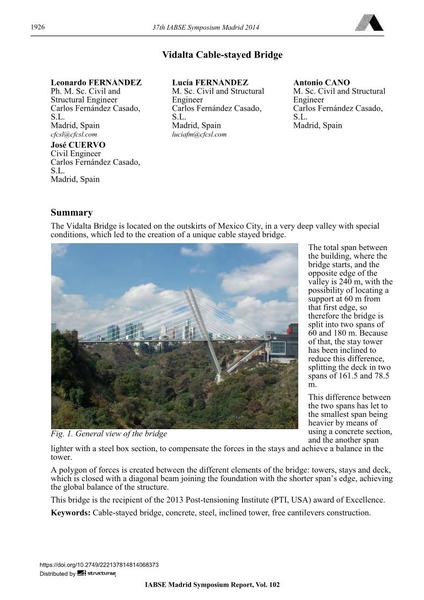Vidalta Cable-stayed Bridge

|
|
|||||||||||
Détails bibliographiques
| Auteur(s): |
Leonardo Fernández
Lucía Fernández Antonio Cano José Cuervo |
||||
|---|---|---|---|---|---|
| Médium: | papier de conférence | ||||
| Langue(s): | anglais | ||||
| Conférence: | IABSE Symposium: Engineering for Progress, Nature and People, Madrid, Spain, 3-5 September 2014 | ||||
| Publié dans: | IABSE Symposium Madrid 2014 | ||||
|
|||||
| Page(s): | 1926-1931 | ||||
| Nombre total de pages (du PDF): | 6 | ||||
| Année: | 2014 | ||||
| DOI: | 10.2749/222137814814068373 | ||||
| Abstrait: |
The Vidalta Bridge is located on the outskirts of Mexico City, in a very deep valley with special conditions, which led to the creation of a unique cable stayed bridge. Fig. 1. General view of the bridge The total span between the building, where the bridge starts, and the opposite edge of the valley is 240 m, with the possibility of locating a support at 60 m from that first edge, so therefore the bridge is split into two spans of 60 and 180 m. Because of that, the stay tower has been inclined to reduce this difference, splitting the deck in two spans of 161.5 and 78.5 m. This difference between the two spans has let to the smallest span being heavier by means of using a concrete section, and the another span lighter with a steel box section, to compensate the forces in the stays and achieve a balance in the tower. A polygon of forces is created between the different elements of the bridge: towers, stays and deck, which is closed with a diagonal beam joining the foundation with the shorter span’s edge, achieving the global balance of the structure. This bridge is the recipient of the 2013 Post-tensioning Institute (PTI, USA) award of Excellence. |
||||
| Mots-clé: |
acier béton Pont à haubans
|
||||

